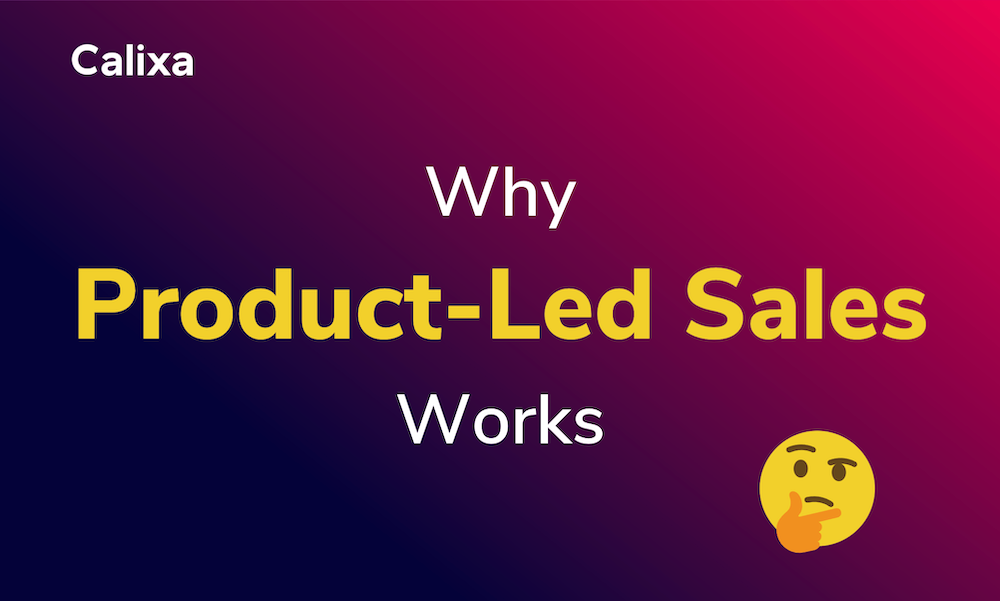Product-led sales sounds like an oxymoron. Doesn't 'Product-led' mean 'No Sales?'
Not exactly!
Product-led sales is a GTM motion where new prospects sign up for free product experiences. Sales teams then leverage product insights to see when and how to best reach out.
Sounds simple enough. But it leaves some open questions:
- How can self-serve and sales reps co-exist?
- How can 'low touch' sales bring high impact?
- Why can't the product just sell itself?
These are longstanding questions about the role of automations vs humans. To answer these questions, we first need to ask 'Why now?' Companies are rapidly opening up their products for free signups.
Why is there a new GTM motion emerging?
Buyers want quick time-to-value
Gartner shocked the B2B world a couple years ago with its report on The SaaS Buying Experience. Everyone was amazed how 'buyers are completing a little over 60% of the buying process before engaging a vendor.'
This statistic quantified what sales reps were seeing on the front lines: people don't want to talk to sales too soon.
Put yourself in the buyer's shoes. Would you rather do quick research and 'try before you buy'–or do you want to jump through hoops to see the product?
Both intuitively and from the Gartner report, we know that the first to help buyers wins their business: 'You need to make sure that buyers find your trial first—and that you don't squander that opportunity when you get it.' Otherwise, they'll simply go somewhere else.
That's why companies now offer free product experiences with quick time-to-value. Product-led companies lean into this trend. Why? Because self-educating prospects is a win-win-win.
It's a win for top-level buyers. Gartner wrote that 'With so much information available and SaaS being a lower-risk investment, many decision-makers are delegating the buying process to others.' They no longer have to worry about lengthy demos or extensive POC for their team.
It's a win for the end users. Vendors race to empower them with immediate access and value from the product. With decision-making less concentrated, internal leadership is supportive of granting these tools.
It's a win for sales reps. Remember when marketing automation (download ebook, watch webinar, etc.) relieved inbound salespeople from basic buyer education? Product-led motions take this one step further–not only did the lead read an ebook, but they've actually explored product features. Product experiences essentially automate the top half of the funnel, so sales reps can focus on areas of high impact.
The top-level buyer delegates, the end user finds quick value, and the sales rep gets warm leads.
Along the way, everybody saves time.
People want to buy from people
If product experiences are so powerful, why not just go all the way? Can't we self-serve the purchasing process too?
Many product-led companies do offer self-serve upgrades to a paid tier. But it isn't enough. Redpoint conducted this study on free trials. 75% of the product-led companies they surveyed have salespeople contact freemium leads.

Sales teams accelerate organic free-to-paid conversion by 3x. What it comes down to is that people still buy from people.
Conversations between sales reps and users can happen proactively or reactively. Some signups are hand-raisers who request assistance.
But with thousands of free signups, most aren't hand-raisers. In that case, the sales rep must proactively engage with people who show intent as Product Qualified Leads (PQLs). These leads may be power users looking for more features. PQLs have clear opportunities–and high conversions–for upgrades.
The size of those upgrades will definitely range. Yet human connection is especially important for large deals (common to 'land and expand' SaaS sales).
Large commitments tend to have more buyer friction:
- People get stuck on a complex use case, or the sales rep needs to equip a use case for the buyer.
- People need help navigating pricing plans.
- People want to discuss enterprise capabilities, such as account consolidation, security, and governance.
No matter how automated or self-serve the buyer journey gets…there will always be sales complexity that exists OUTSIDE of the product.
Product-led does not mean product-only.
Meet buyers where they are
The product is a strong foundation to a good sale. Self-educated buyers can chat with sales prior to expansion deals.
In this new selling environment, viewing PQLs is crucial for understanding product context. By the time that sales touch comes in, sales reps will be exactly where they're needed at the highest point of impact.
With the right data and tools, sales reps will be well-informed to help customers through value-driven narratives. Salespeople are just as valuable–if not more–in a PLG motion.





.png)



